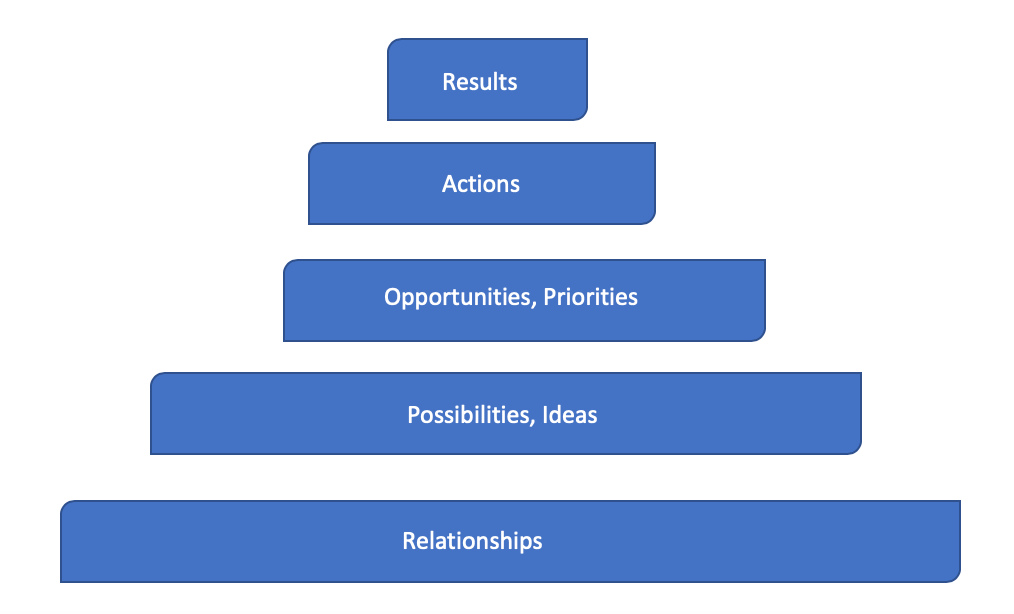I’ve read a book recently, called ‘Leadership plain and simple’ by Steve Radcliffe and it has a lovely, uncomplicated model for leadership. His model has three steps – Future, Engage, Deliver. Having read the book last month, I’ve been reflecting on this model today, during these difficult times of coronavirus. I’ve seen lots of people on social media, saying that this is a time to slow down and reflect. What better than to pause to think of something so central as to how we lead others?
This blog is mainly focused on those that lead teams. However, leadership can be considered in a very broad way. You can be a leader even if you don’t have this as an official part of your role at work, or you can be a leader in your own life. One thing to remember is most people have the capacity to be a leader. It’s not something that requires qualifications or seniority.
In the ‘engage’ stage of the model, I also address some ideas for working remotely.
Three steps – Future, Engage, Deliver
So briefly summarising the three steps:
Step 1: The Future
The future stage sets out the vision and this is where you focus on what you really care about as a leader. In addition to this you can think about the reasons behind what you really want to lead for. So here, spend some time on personal reflection, answering the questions:
- What is important for me right now and what do I care about as a leader?
- What are the reasons behind me wanting to lead in this area?
The answers to these questions are likely to be connected to each other. You really care about something, so you want to take action and leadership (either just by yourself, or by taking others along with you). Radcliffe talks about having the creative mindset of always ‘being up to something’, as a way of keeping yourself motivated and with a focus on the future.
Using ‘conscious practice’ in leadership
Conscious practice is when you slow down and deliberately do something in a certain way. I like to describe it as a ‘hang on a second’ moment and you think about the choices you have. It’s the opposite of carrying out your life in automatic pilot. Taking a slow, considered approach to how you go about things can be very liberating. Therefore, you think about how you are using your leadership muscles in a very deliberate way.
Here it’s also important that you don’t have a limiting mindset – where you think that you can’t be a leader. He also points out that being in manager/operator mindset is something to watch for, so that you’re not slipping into this mode.
Step 2: Engage
Engage is the second stage and this is about your impact on others. It’s about connecting with other people, using emotional intelligence to engage with others and to get stuff done. Getting feedback from others and not just telling people what to do is crucial here. There can be different levels of engagement from resistance, apathy, grudging compliance, willing compliance and then being enrolled and committed.
In these times of working remotely, if you are a team leader, or want to take a leadership role in a project, how you go about engaging with other people will be especially important. Here are several ideas:
- How about proposing an early morning virtual team meeting? A meeting where each team member gets to talk about what they’ve achieved and what they want to get done, can be really motivating for all.
- It’s good to look into which platforms offer the best facilities for chatting remotely and you can set up 1:1s with your team to stay connected
- Also have some ground rules for your meetings which are agreed by everyone re: format, length, use of videos etc
- Set time limits for your meetings, so that each person chats for a short time only, so that no one person dominates and everyone’s voice is heard. It’s good to hear everyone’s voice in the meeting early on, so that people get used to remote working, as some people will feel wary of communicating in this way.
- Using video for remote working meetings. Some people might not like using video and seeing themselves on the screen. Seeing facial expressions though and communicating this way, does help, especially if you have a long remote, meeting with someone.
The results pyramid
Radciffe uses the pyramid shown in the diagram below to show how important relationships are in getting things done. He also mentions these four aspects of engagement that lead to results.

You’ll need to use your leadership muscles to move your team up the pyramid. Each stage is important:
Possibilities, ideas
This is about asking people to co-invent what the future could look like
Opportunities, priorities
Use co-invention for the team to focus on what areas the team should prioritise and focus on
Actions
Being in your best leadership mode, you’ll need to make big requests from your team in order to get things done. Use conscious practice here to use your leadership muscles, make sure you don’t have limiting beliefs about being a leader (e.g. thinking that you are not worthy of this role).
Throughout, consciously practice being ‘engaging’, rather than ‘transmitting/communicating’.
Notice relationship is the largest rung of the pyramid, you can see therefore how important it is.
Step 3: Deliver
The deliver stage is next. You can deliver through others and if you are part of a team, then it is important that you make big requests of others. Don’t be tempted to just have the tendency to do the job yourself. Take on conscious practice (as explained at the beginning of this blog) of being the leader and avoid being in manager/operator mode.
It’s important to have done a great job in the first two stages, future and engage. Keep reminding yourself of the overall purpose. You’ll need to face up to poor performance, being firm with your team. You can use SMART goals to help them move away from under-delivering, engaging with them so they know your vision and what the consequences of poor-delivery could be for the organisation.
You’ll also want to encourage your team to develop to be leaders themselves. Leadership is not a position that comes from our role title or age. Helping people to distinguish their leader mode from that of operator manager will be key here. That way you’ll find yourself working within a motivated, innovating team, where work becomes more enjoyable. You will also be delivering great results for your organisation.
I hope you enjoyed this blog, there’s some areas that are related that I’ve blogged about in the past that you might be interested in reading:

